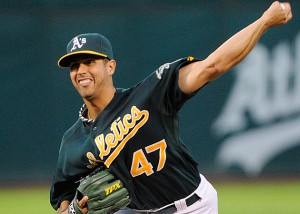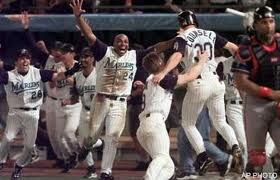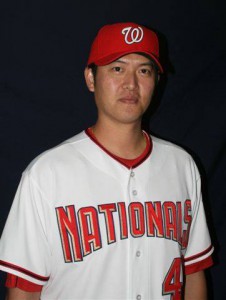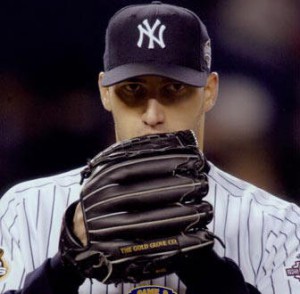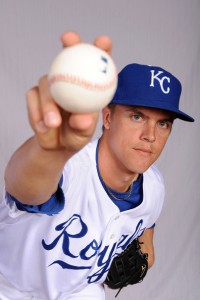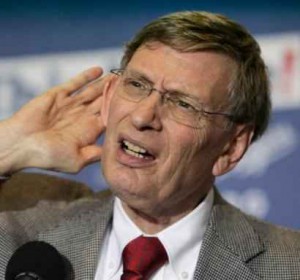
Bud Selig failing to hear calls for him to retire. Photo: ajc.com
(Note: if some of this looks familiar, it is because I started this post in a long-winded answer in a recent “My answers to Boswell’s chat” post).
Ever since Buster Olney posted a June 12th Article raising the topic of “Divisional Realignment,” every baseball columnist and blogger on the internet seemingly has posted their own 2 cents on which team should move leagues and why, opined about how year-long interleague play would be the death of baseball, and other interesting topics (my very fast 2 cents on the pressing questions: move Houston to AL West, who cares about interleague play, and make DH standard in both leagues). The topic came up again at the all-Star game, with Selig talking about “minor” realignment in the future and other topics.
However, what if re-alignment isn’t the best solution to the problem at hand? Yes, it is more difficult to make the playoffs from the NL in general (by virtue of having 16 teams to the AL’s 14) and in the NL central specifically (with 6 teams and a lot of money being spent by a couple of them). Certainly as compared to the AL west with only 4 teams.
Instead of going two leagues of 15 teams each, why don’t we just ADD two more teams to the AL?
If we’re already talking about adding a 5th playoff team to each side via a 2nd wild-card, why not add 2 more teams and have an NFL-style league configuration and playoff structure. 8 divisions of 4 teams each, with 4 division winners and two wildcards in each league. The two wild cards play the lesser two divisional winners, much like in the NFL, giving the two best divisional winners a weekend bye and some semblance of an advantage. If the season ended on (say) a Wednesday, the two wild-card series occur Fri-Sat-Sun with the divisional playoffs to run starting the following Tuesday. It isn’t adding that much time to the playoffs and should be doable.
(Note: other pundits have mentioned this same idea. Keith Law and a blog run by The Common Man have both made mention of the possibility of expanding. Baseball America just posted a missive that leads to the same concept (equal teams in both leagues) but suggests contracting two teams (can’t see that happening, sorry. Too much value in each team to just get rid of them).
Lets talk about the logistics and questions of this:
Which two cities get new teams?
The two current largest metropolitan markets without major league baseball teams right now are Portland and San Antonio, and for a variety of reasons they make the most sense to select. The San Antonio-Austin corridor is growing rapidly and has a large population base of immigrants that enjoys baseball. Portland is a large sophisticated area that only has one major sports franchise, and has a natural wealthy owner in Paul Allen to buy and own the franchise.
Honestly, the two largest US or Canadian cities without baseball are Montreal and Vancouver, but after the complete debacle of the Expos leaving Montreal I’m guessing that Canadian baseball will never get an expansion team again. Vancouver couldn’t keep an NBA team so I’m doubting baseball makes sense up there either. Mexico has a well attended Mexican League, with attendance in the 350,000 for some teams, but the exchange rate issues and current safety issues in the country make it a no-go.
If we were being completely realistic in terms of a population per baseball team, then both New York and Los Angeles really would be the two expansion targets. You could put a team back in Brooklyn (or perhaps Long Island) and then put a team in the Riverside area (which by itself has a larger population than places like Phoenix, Seattle, Minneapolis, and San Diego). However, none of the teams in either market is likely to give up any of their local revenues or TV networks to allow in a third team. So we have to move elsewhere.
A slight potential issue: Portland doesn’t currently support even a AAA franchise. San Antonio/Austin supports several baseball teams and would be a more “sure thing” (The San Antonio Missions is a AA team and the Round Rock Express, north of Austin, is AAA). I don’t believe Portland has any semblance of any pro baseball team; the closest I could find is a Short-A team in Spokane. If you’re using AAA attendance as a bench mark (here’s links to the International league attendance figures, and the Pacific Coast League), then your best bets are cities like Louisville, Indianapolis, Sacramento and Albuquerque. Of these cities, only Indianapolis and Sacramento are really large enough MSAs to make sense. Moving to any California city is problematic because of the current budget nightmare there. Indianapolis is interesting but may struggle to find a fan base sitting in-between Cincinnati and Chicago.
Lots of people talk about somewhere in North Carolina as a potential spot. An area of the country far away from its two closest MLB teams (Washington and Atlanta). Durham hosts a AAA franchise ably enough. The problem would be (as pointed out by Baseball America pundits, who are based in the Research Triangle) that the Triangle area supports a large number of minor league teams, a thriving set of collegiate baseball programs, and a big wood bat league, and a MLB team would probably harm attendance at all of these well supported clubs.
So lets assume for the sake of this argument we’re expanding to Portland and San Antonio.
How would we change the divisional structures to move to 8 divisions of 4 teams each?
The American League is much easier to re-configure than the NL. Here’s how the AL might shake out with two new teams and 4 divisions:
| AL East |
Boston |
NY |
Baltimore |
Toronto |
| AL South |
Tampa Bay |
Texas |
Kansas City |
San Antonio |
| AL Central |
Cleveland |
Detroit |
Chicago |
Minnesota |
| AL West |
Seattle |
Los Angeles |
Oakland |
Portland |
This plan would preserve most of the major rivalries in the AL while creating some new ones. The AL East and its two juggernaut teams continue to do battle 18 times a year, but the addition of two wild cards means that Toronto and Baltimore have no more excuses. Tampa moves out of the AL east but goes against two like-minded franchises in terms of building on youth in Texas and Kansas City. The AL South has a bit more travel, but Tampa’s strong TV ratings should be maintained with 8pm start times instead of 7pm during its many central time zone trips. San Antonio builds an instant in-division rivalry with their Dallas neighbors. The AL Central keeps its four core teams that have gotten used to competing against each other and are all very geographically close. Finally, the AL west gets an instant Seattle-Portland rivalry while keeping all its games on Pacific time.
The National League has a couple more re-configuration challenges, as we’ll see. Here’s one potential configuration:
| NL East |
Philadelphia |
Atlanta |
NY Mets |
Washington |
| NL “South” |
Florida |
Houston |
St. Louis |
Colorado |
| NL Central |
Milwaukee |
Cincinnati |
Pittsburgh |
Chicago |
| NL West |
San Francisco |
Arizona |
Los Angeles |
San Diego |
The NL East, Central and West all make plenty of sense. The only fault of this plan is what to do with the collection of teams that end up in the NL “South.” Clearly, Colorado is not a “southern” team and is two timezones away from its divisional rivals. This means a lot of divisional games for Florida end up starting at 9pm. This plan also moves your marquee NL franchise (St. Louis) away from its longtime rivals in Chicago. It may be better to try to maintain a bit more geographical sense and keep rivals together.
You could do something a bit more radical to NL teams and longer term divisions, like this:
| NL East |
Philadelphia |
Pittsburgh |
NY Mets |
Washington |
| NL South |
Florida |
Houston |
St. Louis |
Atlanta |
| NL Central |
Milwaukee |
Cincinnati |
Colorado |
Chicago |
| NL West |
San Francisco |
Arizona |
Los Angeles |
San Diego |
Here, the Pirates join the NL east, which joins the two Pennsylvania teams together for a nice little rivalry, plus keeps the four closest North east teams together. Atlanta joins the south allow Florida and Atlanta to stay close together. Houston and St. Louis are relatively close as well. This plan eliminates Colorado from having the 2-time zone divisional rivals; there’s just no natural spot for Colorado to go unless you completely re-made the league and created a 4-team division with Colorado and the 3 Texas teams. The only downside to this plan is that St. Louis loses its divisional history with long-time NL teams Milwaukee, Cincinnati and Chicago.
Here’s another attempt, trying to keep the four longest running NL central teams together somehow:
| NL East |
Philadelphia |
Pittsburgh |
NY Mets |
Washington |
| NL Central |
Colorado |
Houston |
Atlanta |
Florida |
| NL Midwest |
Milwaukee |
Cincinnati |
St. Louis |
Chicago |
| NL West |
San Francisco |
Arizona |
Los Angeles |
San Diego |
This may be your best solution. Florida and Atlanta stick together but must travel to Colorado. The NL Midwest now has four of the oldest teams in the league staying together. Colorado, Houston and Florida stay together, as three of the newest teams in the league.
Would the various rooting interests all approve 2 more teams?
Probably. Here’s several groups who have input:
- Players Union: Two more MLB teams means 80 more full time jobs for union members, so the Players Union would approve. Plus, hundreds more minor league players get jobs and keep their dream alive.
- 2nd-tier American cities: Two more teams has the cascading effect of adding in somewhere between 10 and 12 minor league teams. Two AA cities will get promoted to be AAA cities and there will be more cities out there that get teams that they may have always wanted.
- MLB Owners: would love to pocket expansion fees from two new wealthy owners buying into the league (especially Frank McCourt right about now). I’d guess expansion fees would be somewhere in the $400M-$600M range, split 30 ways. Easy money. The difficult part the Owners would have to accept would be the carving up of TV areas and loss of local revenue for the owners of the Houston and Seattle franchises.
- MLB Hitters: would probably like expansion, which dilutes the pitching pool and aids hitting.
- Fans: will get more wild cards, more playoff teams, a structure that makes sense and seems fairer (no more 16/14 team split leagues).
In fact, the only groups that i’d guess would NOT be in favor of expansion would be Baseball Purists, who gripe at every change in the game and probably still want to live in the 60s-era, no playoffs pennant winners go to the World Series. To them I say this: Baseball used to be the National Pastime, but it has been passed by clearly by Pro Football, College Football, and arguably both professional and collegiate basketball in terms of casual interest. You cannot sit by in situations like this; you must be proactive. Casual fans love playoffs, love the drama, and by keeping more teams involved in pennant races you keep fans coming to the ballparks for more teams, later into the season.
So, why would expansion NOT work?
I can think of a couple major reasons.
1. Splitting up of existing TV markets. We saw what happened when Washington moved into a city that Baltimore “owned” already: Angelos gets handed a regional network and a majority ownership stake. This could give Angelos a massive future revenue stream while permanently hampering the Nationals franchise. This point can’t be emphasized enough; the primary reason the Yankees and Red Sox can spend what they spend is exactly their ownership stakes in the YES Network and NESN respectively.
We’re subsequently seeing a battle now between the league, the owner of San Francisco and the Oakland franchise as the Athletics attempt to move. The Giants “claim” the San Jose market (despite it being a comparable distance away from San Francisco in terms of geography and driving time in the busy Bay Area Peninsula region as Washington is from Baltimore), and do not want to give it up. The Athletics could move further south down the Bay to a city like Fremont (a northern suburb of San Jose), but this would put the majority of the San Jose metropolitan area 20-30 miles from a stadium. The A’s might as well move to Sacramento.
Any existing major city that could be considered for expansion is already “owned” by one of the existing MLB franchises. See this Map of the US by regional network ownership as a reference point: Seattle has already “claimed” Portland and most of northern Oregon as its own, and San Antonio is claimed by BOTH Texas and Houston (who also claim the entirety of Louisiana).
I think asking existing owners to give up territory in their Regional Network map could be a complete roadblock for expansion into any area.
2. Viability of new Markets. Continuing to use Portland and San Antonio as expansion markets would immediately make those two cities among the smallest MSAs in baseball. They would both be larger than Milwaukee, but would be smaller than other notoriously struggling franchises (in terms of revenue) such as Kansas City, Pittsburgh, and Tampa Bay.
However, market size and revenues are not on a linear relationship. A lot has to do with the quality of the stadium, the stadium location and the performance of the team. The Florida Marlins had the lowest 2009 revenue (according to Forbes) yet play in Miami, the 6th largest metropolitan area. Clearly the poor stadium is a major factor to their lack of attendance, but the fans also seem to be turned off by the perpetually shady owner Jeffrey Loria. It will be a very interesting case study to see how the Marlins do once they move into their new stadium, which should give the fans a better experience and give the Marlins a better revenue stream from luxury boxes, concessions, parking and naming rights.
There is continual complaints from fans and players in Tampa Bay (here’s a recent article that summarizes the issues they face, but the same issues are repeated over and again in the two local papers down there) over the sorry state of attendance at their games. Despite being a newer stadium, the constructors of the St. Petersburg stadium made several errors in terms of luxury box flexibility and stadium accessibility. Fans down there attest to this fact; the stadium is impossible to get to, so they stay at home generally and watch. Tampa has historically had great TV ratings but awful in-person attendance. This year (per the above article) despite still being competitive the Rays are drastically down in attendance and TV ratings, possibly a reaction to a perceived white-flag season after dumping so many free agents last year. Florida’s economy is in the tank, and there will be no new stadium financing (especially after Loria’s fleecing of Miami). So Tampa is facing the very real possibility of moving themselves. They’ve even recently had talk of declaring bankruptcy in order to force a new stadium discussion.
If there are existing markets that clearly cannot support baseball, then how can we add two more teams?
In the end, Would I like to see expansion? I think expansion makes more sense than splitting up the leagues and doing interleague every day. If the TV revenue issues can be resolved and somehow these smaller market new additions find stadium deals that make them financially acceptable, then expansion makes the most sense.
